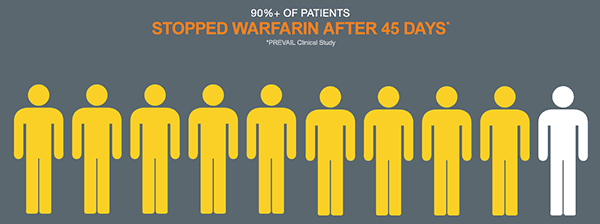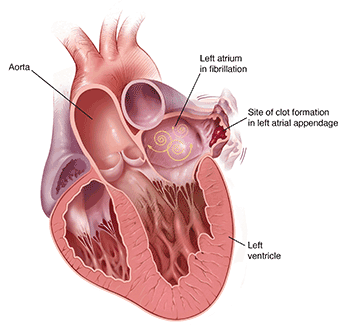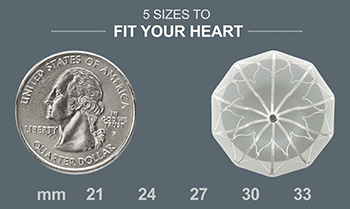How Does AFib Increase Stroke Risk?
The average person with atrial fibrillation (also called AFib or AF) is five times more likely to have a stroke than someone with a regular heartbeat.1 That’s because AFib can decrease the heart’s pumping capacity by as much as 30%.2 Because blood isn’t pumped out of the heart normally, it’s easier for blood cells to stick together and form clots in an area of the heart called the left atrial appendage (LAA).2, 3 When a blood clot escapes from the LAA and travels to another part of the body, it can cut off the blood supply to the brain, causing a stroke.1, 4
In people with atrial fibrillation not caused by heart valve problems (the most common type of AFib), more than 90% of stroke-causing clots that come from the heart are formed in the LAA.3
For more information about AFib or the WATCHMAN procedure, call the Saint Francis Heart Valve Center at 573-331-3369.
Reducing AFib Stroke Risk
Blood thinners, also called anticoagulants, are an effective way to lower the risk of stroke in people with atrial fibrillation not caused by heart valve problems. Common blood thinners include Warfarin (also known as Coumadin®), Eliquis®, Pradaxa®, Xarelto® and Savaysa®.
But some people need an alternative to blood thinners, because they can increase the risk of bleeding. Some bleeding events are minor and easily treated, like a cut taking longer than normal to stop bleeding. In other cases, the bleeding can be life-threatening, such as when bleeding in the brain causes a stroke.
If you have a history of bleeding or a lifestyle, occupation or condition that puts you at risk for bleeding, your doctor may consider an alternative to blood thinners, such as the WATCHMAN Implant.
An Alternative to Blood Thinners
WATCHMAN is a permanent implant that offers an alternative to the lifelong use of blood thinners. It’s about the size of a quarter and made from very light and compact materials commonly used in many other medical implants.
How WATCHMAN Works
WATCHMAN effectively reduces the risk of stroke by permanently closing off the LAA to keep blood clots from escaping. WATCHMAN can eliminate the bleeding risks and regular blood tests and food-and-drink restrictions that come with Warfarin. In a clinical trial, 9 out of 10 people were able to stop taking Warfarin just 45 days after the WATCHMAN procedure.5

How is WATCHMAN Implanted?
WATCHMAN is implanted into your heart in a one-time procedure by Steven J. Joggerst, MD. To implant WATCHMAN, your doctor makes a small cut in your upper leg and inserts a narrow tube, as done in a standard stent procedure. Your doctor then guides WATCHMAN into your heart’s LAA. The procedure is done under general anesthesia and takes about an hour. Patients commonly stay in the hospital overnight and leave the next day.
See how the WATCHMAN Implant procedure works to help reduce stroke risk in people with atrial fibrillation not caused by a heart problem:
After the Procedure
Following the WATCHMAN procedure, you’ll take Warfarin for 45 days or until your LAA is permanently closed off. During this time, heart tissue will grow over the implant to form a barrier against blood clots. Your doctor will monitor this process by taking pictures of your heart to see when you can stop taking Warfarin.
Your doctor will then prescribe a medicine called clopidogrel (also known as Plavix®) and aspirin for you to take for six months. After that, you’ll continue to take aspirin on an ongoing basis. A very small number of patients may need to keep taking blood thinners long term.
In a clinical trial:
- 92% of patients were able to stop taking Warfarin just 45 days after the procedure5
- 99% of patients were able to stop taking Warfarin within 1 year after the procedure5
Is WATCHMAN Right for You?
If you have a history of bleeding or a lifestyle, occupation or condition that puts you at risk for bleeding, WATCHMAN may be right for you. But like any medical procedure, WATCHMAN comes with risks, so it isn’t right for everyone. Your cardiologist will weigh your risk of a stroke against your risk of a serious bleeding problem to determine the right treatment for you.
Take the WATCHMAN Assessment to see if WATCHMAN is right for you.
Hear from WATCHMAN Patients
Ingrid
When atrial fibrillation and the bleeding risks of blood thinners started to slow down Ingrid, an active 55-year-old, she talked to her doctor about an alternative treatment. See how WATCHMAN helped give her a new lease on life.
See how the WATCHMAN Implant helped give Ingrid a new lease on life after AFib and the bleeding risks of blood thinners started to slow her down:
Bill
Bill’s vision problems put him at a higher risk of falling, which increased his risk of having a bleeding event on blood thinners. See how WATCHMAN gave Bill an alternative to blood thinners and helped him enjoy more time out in the garden and walking his rescue greyhound.
See how the WATCHMAN Implant gave Bill an alternative to blood thinners and helped him enjoy more time out in the garden and walking his rescue greyhound:
Getting WATCHMAN
The first step to finding out if you’re a candidate for WATCHMAN is making an appointment with a cardiologist to discuss your options.
WATCHMAN is for people with atrial fibrillation not caused by a heart valve problem who need an alternative to Warfarin. This website is intended to provide patients and caregivers with some information about the WATCHMAN Implant. It may help prepare you for talking to your doctor about your options for reducing stroke risk.
For more information about AFib or the WATCHMAN procedure, call the Saint Francis Heart Valve Center at 573-331-3369.
Important Safety Information
The WATCHMAN Device is a permanent implant designed to close the left atrial appendage in the heart in an effort to reduce the risk of stroke.
With all medical procedures there are risks associated with the implant procedure and the use of the device. The risks include but are not limited to accidental heart puncture, air embolism, allergic reaction, anemia, anesthesia risks, arrhythmias, AV (Arteriovenous) fistula, bleeding or throat pain from the TEE (Trans Esophageal Echo) probe, blood clot or air bubbles in the lungs or other organs, bruising at the catheter insertion site, clot formation on the WATCHMAN™ Closure Device, cranial bleed, excessive bleeding, gastrointestinal bleeding, groin puncture bleed, hypotension, infection/pneumonia, pneumothorax, pulmonary edema, pulmonary vein obstruction, renal failure, stroke, thrombosis and transient ischemic attack. In rare cases death can occur.
Be sure to talk with your doctor so that you thoroughly understand all of the risks and benefits associated with the implantation of the WATCHMAN Device.
Sources
- National Stroke Association. “Making the Afib-Stroke Connection.” Published 2012. Accessed September 1, 2016.
- Harvard Health Publications. “Atrial fibrillation: Common, Serious, Treatable.” Harvard University Medical School. Published November 2011. Accessed August 25, 2016.
- Blackshear JL, Odell JA. “Appendage obliteration to reduce stroke in cardiac surgical patients with atrial fibrillation.” Ann Thorac Surg. 1996;61:755-759.
- Cleveland Clinic. “Atrial fibrillation (Afib).” Published May 2015. Accessed August 25, 2016.
- Holmes DR Jr, Kar S, Price MJ, et al. “Prospective randomized evaluation of the Watchman Left Atrial Appendage Closure device in patients with atrial fibrillation versus long-term Warfarin therapy: the PREVAIL trial.” J Am Coll Cardiol. 2014;64(1):1-12.



